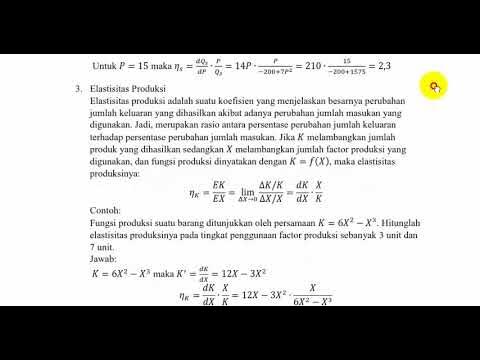Y1/IB 12) Price Elasticity of Supply (PES)
Summary
TLDRThis video explains Price Elasticity of Supply (PES), detailing how it measures the responsiveness of supply to price changes. It covers the formula for PES and explores key factors influencing elasticity, such as production lag, substitutability of factors, level of stocks, spare capacity, and time period. The video uses practical examples and visual aids to demonstrate how different factors affect supply elasticity, including the role of stock levels and spare capacity. It concludes with a general overview of supply elasticity, emphasizing the tendency of commodities to have inelastic supply.
Takeaways
- 😀 PES (Price Elasticity of Supply) measures the responsiveness of quantity supplied to changes in price.
- 😀 According to the law of supply, when the price of a good increases, the quantity supplied increases, and vice versa.
- 😀 The formula for PES is the percentage change in quantity supplied divided by the percentage change in price, and the result is always positive.
- 😀 When PES > 1, supply is considered elastic, meaning quantity supplied changes more than proportionately with price.
- 😀 When PES < 1, supply is considered inelastic, meaning quantity supplied changes less than proportionately with price.
- 😀 The steepness of the supply curve affects elasticity: a steeper curve indicates inelastic supply, while a flatter curve indicates elastic supply.
- 😀 Key factors affecting PES include production lag, substitutability of production factors, level of stocks, spare capacity, and time period.
- 😀 A longer production lag makes supply less elastic because producers can't respond quickly to price changes.
- 😀 The ability to substitute factors of production (e.g., switching between producing different goods) increases supply elasticity.
- 😀 The more stocks a company has, the more elastic the supply will be, as stocks can be released to meet price changes quickly.
- 😀 In the short run, supply is often inelastic because not all factors of production can be varied, while in the long run, supply tends to be more elastic.
Q & A
What is the definition of Price Elasticity of Supply (PES)?
-Price Elasticity of Supply (PES) measures the responsiveness of the quantity supplied of a good to a change in its price. It shows how much the quantity supplied changes when the price increases or decreases.
How is PES calculated?
-PES is calculated by dividing the percentage change in quantity supplied by the percentage change in price. The formula is: PES = (% change in quantity supplied) / (% change in price).
What does a PES value greater than 1 signify?
-A PES value greater than 1 indicates that the supply is elastic, meaning the quantity supplied responds more than proportionately to a change in price.
What does a PES value less than 1 indicate?
-A PES value less than 1 indicates that the supply is inelastic, meaning the quantity supplied responds less than proportionately to a change in price.
How does the slope of the supply curve relate to supply elasticity?
-The elasticity of supply can be visualized through the slope of the supply curve. A steeper supply curve indicates inelastic supply, meaning that price changes have a small effect on quantity supplied. A flatter curve indicates elastic supply, where quantity supplied changes more significantly with price changes.
What are the main factors that determine the price elasticity of supply?
-The main factors that determine the price elasticity of supply are: production lag, substitutability of factors of production, level of stocks, spare capacity, and time period.
How does production lag affect the elasticity of supply?
-A longer production lag means that supply will be less responsive to price changes. For example, goods like agricultural products have a long production cycle, making their supply inelastic.
What is meant by substitutability of factors of production?
-Substitutability of factors of production refers to the ability of a firm to easily switch its resources (such as labor or machinery) from one type of good to another. If a firm can do this easily, supply is more elastic.
How do stocks and spare capacity influence supply elasticity?
-Firms with high levels of stocks or spare capacity can more easily increase supply when prices rise. High stocks mean that goods can be released quickly to the market, while spare capacity allows firms to increase production without needing new resources.
Why is supply typically inelastic in the short run?
-In the short run, supply is often inelastic because at least one factor of production is fixed. Firms cannot quickly adjust their production capacity or hire additional labor, limiting their ability to respond to price changes.
Outlines

このセクションは有料ユーザー限定です。 アクセスするには、アップグレードをお願いします。
今すぐアップグレードMindmap

このセクションは有料ユーザー限定です。 アクセスするには、アップグレードをお願いします。
今すぐアップグレードKeywords

このセクションは有料ユーザー限定です。 アクセスするには、アップグレードをお願いします。
今すぐアップグレードHighlights

このセクションは有料ユーザー限定です。 アクセスするには、アップグレードをお願いします。
今すぐアップグレードTranscripts

このセクションは有料ユーザー限定です。 アクセスするには、アップグレードをお願いします。
今すぐアップグレード関連動画をさらに表示

Price Elasticity of Supply (PES) | Elasticity | IB Microeconomics

ELASTISITAS PERMINTAAN, PENAWARAN DAN PRODUKSI

The 4 Types of Elasticity Explained | Economic Homework | Think Econ

Price elasticity of supply

Elastisitas Harga Permintaan / Penawaran & Elastisitas Silang - Materi Kelas 10 Ekonomi SMA Bab 4.4

ELASTISITAS PERMINTAAN DAN PENAWARAN
5.0 / 5 (0 votes)
